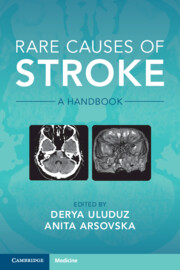Book contents
- Rare Causes of Stroke
- Rare Causes of Stroke
- Copyright page
- Contents
- Contributors
- Preface
- 1 Inflammatory Conditions
- 2 Infectious and Postinfectious Vasculitis
- 3 Hypercoagulable Causes of Stroke
- Chapter 3.1 Antiphospholipid Antibody Syndrome
- Chapter 3.2 Hyperhomocysteinemia
- Chapter 3.3 Hyperviscosity Syndrome
- Chapter 3.4 Disseminated Intravascular Coagulation and Moschkowitz Syndrome
- Chapter 3.5 Immunoglobulin A Vasculitis (Henoch–Schönlein Purpura)
- Chapter 3.6 Stroke Associated With Cancer
- 4 Drug-Related Stroke
- 5 Hereditary and Genetic Causes of Stroke
- 6 Rare Causes of Cardioembolism
- 7 Vasospastic Conditions and Other Vasculopathies
- 8 Other Non-inflammatory Vasculopathies
- 9 Venous Occlusive Conditions
- 10 Bone Disorders and Stroke
- Index
- References
Chapter 3.2 - Hyperhomocysteinemia
from 3 - Hypercoagulable Causes of Stroke
Published online by Cambridge University Press: 06 October 2022
- Rare Causes of Stroke
- Rare Causes of Stroke
- Copyright page
- Contents
- Contributors
- Preface
- 1 Inflammatory Conditions
- 2 Infectious and Postinfectious Vasculitis
- 3 Hypercoagulable Causes of Stroke
- Chapter 3.1 Antiphospholipid Antibody Syndrome
- Chapter 3.2 Hyperhomocysteinemia
- Chapter 3.3 Hyperviscosity Syndrome
- Chapter 3.4 Disseminated Intravascular Coagulation and Moschkowitz Syndrome
- Chapter 3.5 Immunoglobulin A Vasculitis (Henoch–Schönlein Purpura)
- Chapter 3.6 Stroke Associated With Cancer
- 4 Drug-Related Stroke
- 5 Hereditary and Genetic Causes of Stroke
- 6 Rare Causes of Cardioembolism
- 7 Vasospastic Conditions and Other Vasculopathies
- 8 Other Non-inflammatory Vasculopathies
- 9 Venous Occlusive Conditions
- 10 Bone Disorders and Stroke
- Index
- References
Summary
Some authors have shown that hyperhomocysteinemia (HHCY) is a risk factor for stroke/TIA mainly in patients with associated other risk factors such as hypertension, dyslipidemia, smoking and carotid atherosclerosis. The mechanism through HHCY acts is only postulated but experimental evidence suggest that endothelial dysfunction generated by reactive oxygen species, platelet activation and thrombus formation play a key role in the pathophysiologic mechanisms of HHCY. It has also been demonstrated that HHCY can represent an independent risk factor for venous thromboembolism and the association between HHCY with factor V Leiden further increase the risk of deep venous thrombosis. Here we reported a case of A 16 year-old woman presented to our emergency room complaining of headache and showing a right facial paresis, a mild defect of motility in her upper right arm, a slurred speech with NIHSS (National Institute of Health Stroke Scale) =7. Magnetic resonance study plus MRI venography were performed which showed an ischemic lesion in the left frontal area and occlusion of the longitudinal superior venous sinus. Her plasma levels of homocysteine was increased (91 µmol/L), so anticoagulation with LMWH and then with warfarin and a therapy with folic acid was started. After a cycle of rehabilitation she was discharged with full recovery. As stroke could have serious impact on the quality of life, HHCY should be considered in all patients with stroke or TIA and eventually treated
- Type
- Chapter
- Information
- Rare Causes of StrokeA Handbook, pp. 157 - 161Publisher: Cambridge University PressPrint publication year: 2022



